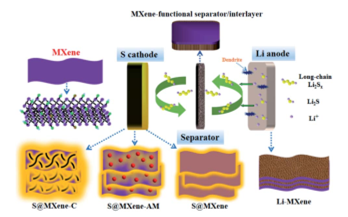JMCA review: MXene-based materials boost lithium-sulfur batteries
QQ Academic Group: 1092348845
Detailed
【Research background 】
The energy crisis and environmental pollution have prompted us to use clean energy such as wind, solar, biogas, and nuclear power to generate electricity. However, due to the intermittent nature of these renewable energy sources, energy storage devices must be developed in order to effectively use them. In this context, electrochemical energy storage based on different redox reactions or Faraday effects is of great significance. Lithium-ion batteries (LIBs) are the most widely used commercial batteries, but there is still a large gap between optimal energy density and growing demand from advanced portable electronic products, electric vehicles and fixed storage Equipment market. At the same time, the relatively high cost and potential safety issues of lithium-ion batteries also hinder their large-scale application in electric vehicles. Therefore, exploring alternative high-energy electrochemical systems is of great significance for changing energy storage methods.
【Introduction 】
The team of Dr. Wang Ruihu from the Fujian Institute of Research on the Structure of Matter, Chinese Academy of Sciences published a review article titled MXene-engineered lithium-sulfur batteries in JMCA. The sulfur battery mechanism is summarized. Lithium-sulfur battery is one of the most promising next-generation energy storage systems. In order to improve the utilization rate and cycle stability of sulfur, people have made great efforts to develop conductive nanostructures. MXenes are a class of two-dimensional transition metal carbides, nitrides, and carbonitrides, which have attracted widespread attention in recent years in terms of energy storage and conversion. This article summarizes the research progress of MXene-based materials in cathodes, anodes and separators of lithium batteries in recent years, emphasizing the theoretical and experimental significance of highly polar and rich surface chemistry in polysulfide capture. The development prospects and challenges of lithium-ion batteries are summarized, and new strategies for improving the electrochemical performance of lithium-ion batteries are proposed, which point out the direction for the future development of lithium-ion materials in high-energy density lithium-ion batteries.
【Graphic introduction 】

Figure 1 a) Energy density of various batteries b) The state of polysulfide at various charging and discharging stages

Figure 2 Mxene-based lithium-sulfur battery research status and basic status

Figure 3 shows the basic structure of MXene-based lithium-sulfur battery


Figures 4 and 5 Schematic diagram of surface functional groups and theoretical simulation calculation of different surface functional groups

Table 1 is the MXene-based lithium-sulfur battery related literature cited in this article. The author divides MXene-based lithium-sulfur materials into MXene-S binary system, MXene-C / S ternary system, MXene-polar material / S ternary system (metal sulfide, oxide and conductive polymer).
【Article Summary 】
This article reviews the theoretical and experimental research progress of MXene-based materials in lithium batteries in recent years. MXene is used as an additive or conductive matrix in cathodes, anodes and separators, which greatly suppresses the shuttle effect and accelerates the use of sulfur. Therefore, even in the case of high sulfur loading, high discharge capacity and rate performance can be obtained And cycle stability. Although considerable achievements have been made in lithium-ion batteries, there are still some inherent problems that need to be further solved to improve the electrochemical performance of lithium-ion batteries.
Literature link:
DOI: 10.1039 / c9ta08600e
Source:
- Previous: Overview of MXene Micr
- Next: MXene breakthrough: Na


 mxene academic
mxene academic
